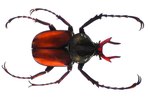
The species Clibanarius vittatus is known as either the thinstripe hermit crab or the striped hermit crab. Abundant numbers of this crab live in the waters stretching from the coast of Virginia down to Brazil: areas of the Florida Atlantic coast provide an ideal habitat for the thinstripe hermit crab.
Description
According to the Smithsonian Marine research station at Fort Pierce, the thinstripe hermit crab is easy to recognize. He has a greenish to brownish body with distinctive white or gray stripes running across his back, although you are able to see the stripes more clearly on his legs. His legs—correctly called chelipeds—are equal in size, and each has a claw. The claws are a cylindrical shape, equal in size and covered in blue tubercles (small bumps). Each claw opens horizontally to reveal teeth. In general he measures from 14 to 17 mm in length, and according to the Smithsonian he often lives in shells that measure 10 cm in length. The thinstripe crab often has a sea anemone attached to his shell. This is a mutually convenient relationship: the crab provides transport for the anemone and the anemone camouflages the crab and may even protect him from predators with its stinging tentacles.
Habitat
The thinstripe hermit crab's typical habitat is a sheltered beach, mud or sand flats, seagrass beds, rock jetties, mangrove swamps and oyster beds of the United State's southerly Atlantic coastal region. He lives in water up to a depth of 72 feet, but this crab is able to tolerate dry conditions better than some other crab species, so he's often found living in exposed areas such as a beach at low tide or a tidal flat.
Reproduction
The thinstripe crab reproduces in a similar way to other crustaceans. The male fertilizes the female crab's eggs via copulation. She then lays these eggs on her abdomen about one hour after mating. She can carry between 1,000 and 30,000 eggs on her abdomen in a mass called a "sponge." The mating season is between April and September and according to the Smithsonian, because the female can reproduce in large quantities, she may produce up to 180,000 baby crabs annually. The time it takes for eggs to develop depends on the temperature and salinity of the sea water, but is typically between 24 and 91 days.
Environmental Considerations
The thinstripe prefers an environment that ranges from temperate to tropical. Marine research reports that this crab chooses warmer waters because its eggs develop more rapidly at higher temperatures, even though an adult crab may be able to tolerate colder water. For example, eggs laid in a water temperature of 77 degrees Fahrenheit take about 60 days to reach the baby stage, while eggs laid in a temperature 59 degrees Fahrenheit never develop. This species is an opportunistic feeder and eats what he can of both plant and dead animal material. He also uses his claws to break open small biovalve mollusks such as small limpets or clams.
References
Photo Credits
-
Gary Faber/Digital Vision/Getty Images
Writer Bio
Based in London, Eleanor McKenzie has been writing lifestyle-related books and articles since 1998. Her articles have appeared in the "Palm Beach Times" and she is the author of numerous books published by Hamlyn U.K., including "Healing Reiki" and "Pilates System." She holds a Master of Arts in informational studies from London University.



